港口国监督英语材料
- 格式:doc
- 大小:63.50 KB
- 文档页数:17
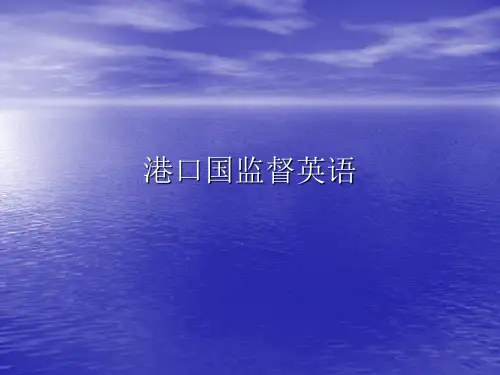
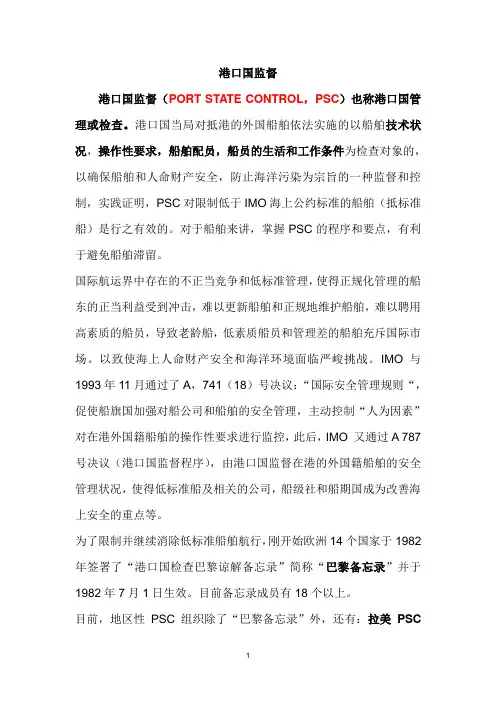
港口国监督港口国监督(PORT STATE CONTROL,PSC)也称港口国管理或检查。
港口国当局对抵港的外国船舶依法实施的以船舶技术状况,操作性要求,船舶配员,船员的生活和工作条件为检查对象的,以确保船舶和人命财产安全,防止海洋污染为宗旨的一种监督和控制,实践证明,PSC对限制低于IMO海上公约标准的船舶(抵标准船)是行之有效的。
对于船舶来讲,掌握PSC的程序和要点,有利于避免船舶滞留。
国际航运界中存在的不正当竞争和低标准管理,使得正规化管理的船东的正当利益受到冲击,难以更新船舶和正规地维护船舶,难以聘用高素质的船员,导致老龄船,低素质船员和管理差的船舶充斥国际市场。
以致使海上人命财产安全和海洋环境面临严峻挑战。
IMO 与1993年11月通过了A,741(18)号决议:“国际安全管理规则“,促使船旗国加强对船公司和船舶的安全管理,主动控制“人为因素”对在港外国籍船舶的操作性要求进行监控,此后,IMO 又通过A 787号决议(港口国监督程序),由港口国监督在港的外国籍船舶的安全管理状况,使得低标准船及相关的公司,船级社和船期国成为改善海上安全的重点等。
为了限制并继续消除低标准船舶航行,刚开始欧洲14个国家于1982年签署了“港口国检查巴黎谅解备忘录”简称“巴黎备忘录”并于1982年7月1日生效。
目前备忘录成员有18个以上。
目前,地区性PSC 组织除了“巴黎备忘录”外,还有:拉美PSC协定(1992.1110),亚太地区PSC谅解备忘录(1993.12.2).加勒比海地区谅解备忘录(1996.2.9). 和地中海地区PSC 谅解备忘录(1997.7.11)。
为了形成一个覆盖全球的既各自独立有彼此衔接的区域性港口国监督网络,IMO 也建立了印度洋地区,波斯湾地区,西非和中非地区的港口国监督体系。
滞留船舶的主要标准:已发现的船舶缺陷是否严重到可能导致滞留时,PSC检查官应判断是否:1,船舶具有相关的有效证书文件:2,船舶具有“最低安全配员文件”要求的船员。

Hammer 铁锤Handling charge 装卸费,搬运费Harbour海港Harbour administration bureau(harbour bureau) 港务局Harbour dues港务费Harbourlight 港口灯标Harbouroffice 港监,海监局Harbour supervisionoffice 港务监督Hatch (hatchcover)舱盖Hatchbeam 舱盖横梁Hatchway 舱口Hawse hole 锚链孔Headline头缆Heavingline 撇缆Heavy-dutyforklift trucks巨型堆高机(香港俗称麻鹰)Heavy fog 大雾Heavy lift超重货物,大件Heavylift additional(surcharge)超重附加费Heavy lift derrick重型吊杆Heavy rain 大雨Heavysnow 大雪ﻫHeavyweather 恶劣天气Helm舵轮,舵柄High cube container(HC) 大型集装箱Hirestatement 租金单Hold 船舱ﻫHome port 船籍港Homogeneous cargo同种货物Hook 吊钩Hoop iron missing 铁箍失落Hull 船体,船身ﻫIce-breaker破冰船Identity ofcarrier clause承运人责任条款IMMO危险品类别Import(IM) 进口Import entry 进口报关Import/export tariff 进口/出口税率Import permit 进口许可证Indemnity 赔偿Inflation adjustmentfactor (IAF) 通货膨胀膨胀调整系数Infrastructure(of a port) (港口)基础设施Inland transportation charge 内陆运输费Import manifest 载货清单Inspection certificate 检验证书Inspection ofhold 验舱Insufficient packing包装不足Insulatedcontainer保温集装箱Insurance 保险International MaritimeOrganization (IMO)国际海事组织International Association ofClassificationSocieties (IACS)国际船级社协会International conventionfor safecontainer(CSC) 国际集装箱安全公约International Maritime DangerousGoods Code (IMDG)国际海上危险品货物规则(国际危规)International multimodal transportconvention国际多式联运公约International standardizationorganization(ISO) 国际标准化组织International TransportWorkers’ Federation (ITF)国际运输工人联合会Inthe middle 在中间Inventory control 存货控制Inward进港的Inwardcargo 进港货Inwardmanifest 进口舱单Ironnail铁钉Jackladder(jacob’s ladder) 软梯,绳梯Jammedat the side 箱边压坏Joint 结头Joint inspection联检Joint service 联合服务ﻫJointsurvey联合检验Jumbo derrick 重型吊杆Keel 龙骨Kilos. 公斤,千克Kind of Pkgs。
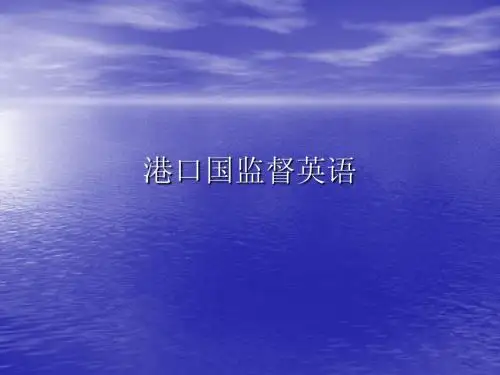
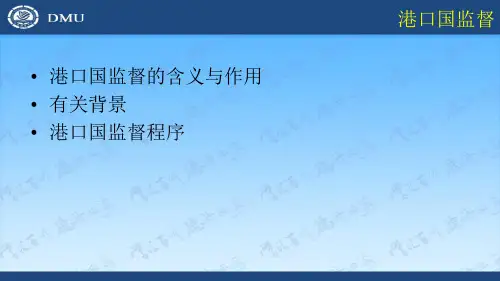
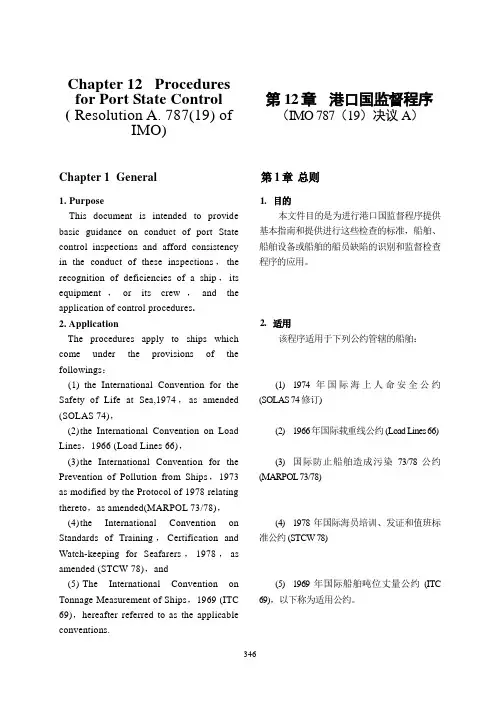
Chapter 12 Procedures for Port State Control ( Resolution A. 787(19) ofIMO)Chapter 1 General1. PurposeThis document is intended to provide basic guidance on conduct of port State control inspections and afford consistency in the conduct of these inspections,the recognition of deficiencies of a ship,its equipment,or its crew,and the application of control procedures.2. ApplicationThe procedures apply to ships which come under the provisions of the followings:(1)the International Convention for the Safety of Life at Sea,1974,as amended (SOLAS 74),(2)t he International Convention on Load Lines,1966 (Load Lines 66),(3)t he International Convention for the Prevention of Pollution from Ships,1973 as modified by the Protocol of 1978 relating thereto,as amended(MARPOL 73/78),(4)t he International Convention on Standards of Training,Certification and Watch-keeping for Seafarers,1978,as amended (STCW 78),and(5)The International Convention on Tonnage Measurement of Ships,1969 (ITC 69),hereafter referred to as the applicable conventions.第12章港口国监督程序(IMO 787(19)决议A)第1章总则1.目的本文件目的是为进行港口国监督程序提供基本指南和提供进行这些检查的标准,船舶、船舶设备或船舶的船员缺陷的识别和监督检查程序的应用。
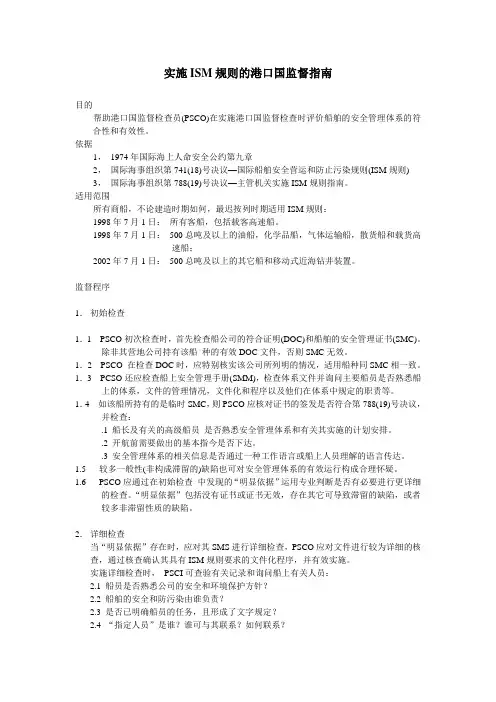
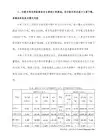
第一章港口国监督和船旗国监督概述第一节港口国监督的由来与发展一、港口国监督的概念港口国监督(PORT STATE CONTROL)是港口国对进入本国港口的外国籍船舶实施的检查行为,目的在于监督这些船舶是否遵守和符合其所适用的国际公约的规定和安全标准。
港口国监督的一般方式是对船舶实施检查,发现船舶存在的缺陷,要求船舶纠正发现的缺陷,如船舶存在的缺陷严重危及船舶航行安全或海洋环境,可对船舶采取滞留措施直至缺陷纠正。
二、港口国监督的由来港口国监督由来已久,它是随有关国际公约的诞生而出现的,其中包括《联合国海洋法公约》、国际海事组织有关公约,如《海上人命安全公约》、《防止船舶污染海洋公约》等。
这些国际公约对缔约方在作为港口国时的权利和义务做了明确规定,同时也对船旗国如何确保公约的执行作出了规定。
所以,任何一个公约缔约方都可按照公约规定实施港口国监督检查。
但实际上,在国际上第一个港口国监督区域性合作组织--巴黎港口国监督谅解备忘录组织成立之前,只有少数西方发达国家开展了港口国监督检查,检查的内容也限于船舶的证书和文件上,在国际上的影响也不是很大。
1978年3月17日,利比里亚籍油轮AMOCO CADIZ号在法国的BRITTANY海岸搁浅,造成溢油23万吨的严重污染事故。
这是导致巴黎港口国监督谅解备忘录产生的直接原因。
由于这起溢油事故造成了巨大的经济损失和不良社会影响,在强大的社会压力下,1980年12月,法国海洋部长邀请西、北欧13个国家的有关当局的部长们召开会议,就如何加强对进入本地区的外国籍船舶实施检查进行了研究讨论,并形成了一致意见,决定对船舶的实际技术状况进行检查并采取区域性统一行动。
会后由设立的工作组起草了港口国监督详解备忘录。
1982年1月,13个国家的部长们再次会聚,在巴黎签署了该备忘录。
巴黎备忘录于1982年7月1日正式生效实施(正式实施时为14国)。
1983年国际海事组织通过了第466号决议,基本采用了巴黎备忘录确定的原则,制定了港口国监督的程序和导则,从而以国际会议决议的形式规定了港口国监督对船舶由单纯的证书的检查转向对船舶设备的安全检查。
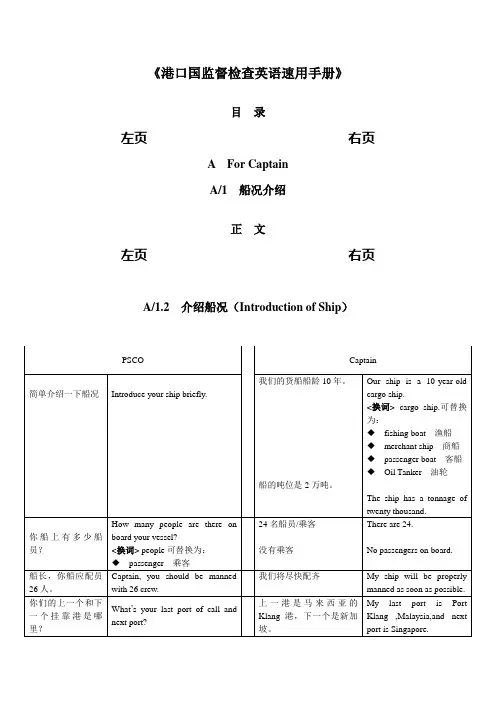

第一章港口国监督和船旗国监督概述第一节港口国监督的由来与发展一、港口国监督的概念港口国监督(PORT STATE CONTROL)是港口国对进入本国港口的外国籍船舶实施的检查行为,目的在于监督这些船舶是否遵守和符合其所适用的国际公约的规定和安全标准。
港口国监督的一般方式是对船舶实施检查,发现船舶存在的缺陷,要求船舶纠正发现的缺陷,如船舶存在的缺陷严重危及船舶航行安全或海洋环境,可对船舶采取滞留措施直至缺陷纠正。
二、港口国监督的由来港口国监督由来已久,它是随有关国际公约的诞生而出现的,其中包括《联合国海洋法公约》、国际海事组织有关公约,如《海上人命安全公约》、《防止船舶污染海洋公约》等。
这些国际公约对缔约方在作为港口国时的权利和义务做了明确规定,同时也对船旗国如何确保公约的执行作出了规定。
所以,任何一个公约缔约方都可按照公约规定实施港口国监督检查。
但实际上,在国际上第一个港口国监督区域性合作组织--巴黎港口国监督谅解备忘录组织成立之前,只有少数西方发达国家开展了港口国监督检查,检查的内容也限于船舶的证书和文件上,在国际上的影响也不是很大。
1978年3月17日,利比里亚籍油轮AMOCO CADIZ号在法国的BRITTANY海岸搁浅,造成溢油23万吨的严重污染事故。
这是导致巴黎港口国监督谅解备忘录产生的直接原因。
由于这起溢油事故造成了巨大的经济损失和不良社会影响,在强大的社会压力下,1980年12月,法国海洋部长邀请西、北欧13个国家的有关当局的部长们召开会议,就如何加强对进入本地区的外国籍船舶实施检查进行了研究讨论,并形成了一致意见,决定对船舶的实际技术状况进行检查并采取区域性统一行动。
会后由设立的工作组起草了港口国监督详解备忘录。
1982年1月,13个国家的部长们再次会聚,在巴黎签署了该备忘录。
巴黎备忘录于1982年7月1日正式生效实施(正式实施时为14国)。
1983年国际海事组织通过了第466号决议,基本采用了巴黎备忘录确定的原则,制定了港口国监督的程序和导则,从而以国际会议决议的形式规定了港口国监督对船舶由单纯的证书的检查转向对船舶设备的安全检查。
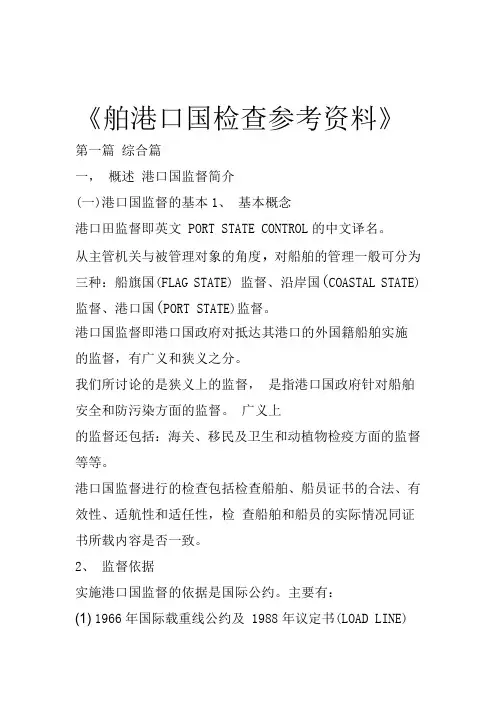
《舶港口国检查参考资料》第一篇综合篇一,概述港口国监督简介(一)港口国监督的基本1、基本概念港口田监督即英文 PORT STATE CONTROL的中文译名。
从主管机关与被管理对象的角度,对船舶的管理一般可分为三种:船旗国(FLAG STATE) 监督、沿岸国(COASTAL STATE)监督、港口国(PORT STATE)监督。
港口国监督即港口国政府对抵达其港口的外国籍船舶实施的监督,有广义和狭义之分。
我们所讨论的是狭义上的监督,是指港口国政府针对船舶安全和防污染方面的监督。
广义上的监督还包括:海关、移民及卫生和动植物检疫方面的监督等等。
港口国监督进行的检查包括检查船舶、船员证书的合法、有效性、适航性和适任性,检查船舶和船员的实际情况同证书所载内容是否一致。
2、监督依据实施港口国监督的依据是国际公约。
主要有:(1) 1966年国际载重线公约及 1988年议定书(LOAD LINE)控制条款:Article21(2) 经修正的1974年国际海上人命安全公约及其 1978年、1988年议定书(SOLAS);控制条款:Regulation 1/19(3) 经1978年议定书修正的1973年国际防止船舶造成污染公约(MARPOL);控制条款:Article 5(4) 1978年海员培训、发证和值班标准公约(STCW);控制条款:: Article X(5) 1972年国际海上避碰规则(COLREG); 纳入SOLAS(RegulationI/ 7、8)(6) 1969年国际吨位丈量公约(TONNAGE), 控制条款,Article l2(7) 国际劳工组织的商船(最低标准)公约(ILO147)。
控制条款:Article 4另外,NMFT —不予优惠条款为合理运用公约并掌握检查标准提供了依3、监督目的首先实施港口国监督的西方发达国家认为,低于标准船舶(大多是老旧船舶)与有良好营运管理记录的船舶在同一个市场经营应被视为不公平竞争。
第一章定义和常用缩略语一、定义1. Clear grounds: evidence that the ship, its equipment, or its crew does not correspond substantially with the requirements of the relevant conventions or that the master or crewmembers are not familiar with essential shipboard procedures relating to the safety of ships or the prevention of pollution.明显依据:船舶及其设备或其船员实质上不符合有关公约的要求的证据,或船长或船员不熟悉有关船舶安全或防止污染的船上基本程序的证据。
2. Deficiency: A condition found not to be in compliance with the requirements of the relevant convention.缺陷:发现的不符合有关公约要求的一种状况3. Detention: Intervention action taken by the port State when the condition of the ship or its crew does not correspond substantially with the applicable conventions to ensure that the ship will not sail until it can proceed to sea without presenting a danger to the ship or persons on board, or without presenting an unreasonable threat of harm to the marine environment.滞留:当船舶或船员实质上不符合适用公约要求时,港口国为保证该船舶只有在不会对船舶或船上人员构成危险或不会对海上环境造成损害威胁时方可开航所采取的干涉行动。
《舶港口国检查参考资料》第一篇综合篇一,概述港口国监督简介(一)港口国监督的基本概念1、基本概念港口田监督即英文PORT STATE CONTROL的中文译名。
从主管机关与被管理对象的角度,对船舶的管理一般可分为三种:船旗国(FLAG STATE)监督、沿岸国(COASTAL STATE)监督、港口国(PORT STATE)监督。
港口国监督即港口国政府对抵达其港口的外国籍船舶实施的监督,有广义和狭义之分。
我们所讨论的是狭义上的监督,是指港口国政府针对船舶安全和防污染方面的监督。
广义上的监督还包括:海关、移民及卫生和动植物检疫方面的监督等等。
港口国监督进行的检查包括检查船舶、船员证书的合法、有效性、适航性和适任性,检查船舶和船员的实际情况同证书所载内容是否一致。
2、监督依据实施港口国监督的依据是国际公约。
主要有:(1)1966年国际载重线公约及1988年议定书(LOAD LINE)控制条款:Article21(2)经修正的1974年国际海上人命安全公约及其1978年、1988年议定书(SOLAS);控制条款:Regulation I/19(3)经1978年议定书修正的1973年国际防止船舶造成污染公约(MARPOL);控制条款:Article 5(4)1978年海员培训、发证和值班标准公约(STCW);控制条款::Article X(5)1972年国际海上避碰规则(COLREG);纳入SOLAS(Regulation I/7、8)(6)1969年国际吨位丈量公约(TONNAGE),控制条款,Article l2(7)国际劳工组织的商船(最低标准)公约(ILO147)。
控制条款:Article 4另外,NMFT一不予优惠条款为合理运用公约并掌握检查标准提供了依据。
3、监督目的首先实施港口国监督的西方发达国家认为,低于标准船舶(大多是老旧船舶)与有良好营运管理记录的船舶在同一个市场经营应被视为不公平竞争。
港口国监督--------PORT STATE CONTROL1.什么是港口国监督?-----What is the Port State Control (PSC)答: 每个国家都有主权对在其领土管辖内作业的外国船舶进行监督.此外, 国际海事组织和国际劳工组织在制定的一些国际海事公约中亦规定, 各国对到访其港口的外国船舶进行监督检查,这就是港口国监督.A: Each nation has the sovereign right to exercise control over foreign flag ship which are operating within areas under it’s territorial jurisdiction. In addition, a number of international maritime conventions adopted by the IMO and ILO provide nations with the instruments to conduct control inspections of foreign ships visiting their ports.This is Port State Control (PSC).2.什么是PSC的区域协作? ----What is the regional co-operation of PSC ?答: 1982年七月一日, 14个欧洲国家在巴黎举行会议, 本次会议制定了关于港口国监督的巴黎谅解备忘录.目的是交换受检船舶的检查信息.包括检查的记录和结果, 使检查标准,船舶滞留,和按港口国监督规定进行检查的官员的培训完全统一起来.以至于对低标准船舶和低标准操作的监督工作做的更有效.秘书处设在荷兰的海牙,在法国有一个信息中心,按照协议,每个成员国每年应对停靠在其港口25%以上的外国船舶进行检查, 目前共有18个成员国.A; On 1 July, 1982, 14 Europe countries held a meeting in Paris. The meeting adopted the Paris Memorandum of Understanding on PSC. It’s aim is to exchange information on ships inspected , including the results and records of inspection, and to unify the standards for inspection, ship detention and training of officers doing inspection under PSC. So that on substandard ships and substandard operation will be made more effective. The secretariat is in Hague , the Netherlands. There is an information center in France . as agreed , on national basis 25%of foreign ships calling at its ports should be inspected per year. At present , the number state are 18.3.港口国宝监督检查依据哪些文件?---What instruments are the bases for inspection of PSC ?答:aa-《1966 年国际载重线公约》International convention on Load Lines , 1966. ( LL’66)bb-《1974年国际海上人命公约》International convention the Safety of Life At Sea, 1974. (SOLAS 74)cc-《73/78国际防止船舶造成污染公约》I—N .for the Prevention of Pollution from Ship,73/78 (MARPOL73/78) dd-《78年海员培训;发证和值班标准公约》I-N on standards of Training , Certification and Watch keeping for Seafarers, 1978.(STCW78) ee-《1972年国际海上避碰规则Convention of Int. Regulations for preventing Collision At Sea 1972.(COLREG’72) ff.《69年国际船舶吨位丈量公约》International convention on Tonnage Measurement of Ships, 1969 (ITC’69) gg-ILO76年147号《商船最低标准公约》ILO No.147 Merchant Shipping (Minimum Standarda ) Convention,1976.(ILO CON.147) 4.按照什么程序进行检查? ---Under which procedures is the inspection carried out ?答: 检查的程序规定如下: 港口国监督官上船检查船上是否备有与谅解备忘录目的有关的有效证书和文件.在等船前要进行计算机查询.如果船舶在此之前6个月内已经由谅解备忘录范围内其他港口国当局检查过, 并且情况正常, 除非有明显理由要再做检查, 原则上此船可不再检查. 如果在检查中一切正常, 港口国监督员在离船前要出具”清洁”检查报告,既无缺陷报告给船长,同时将检查结果报告信息中心. 如果船上没有要求的证书或证书失效或有明显理由认为船舶实际上不符合有关公约的要求,则要进行更详细的检查.A: The procedures for inspection are stipulated as following:The PSC may board a ship and check whether valid certificates and documents relevant for the purpose of the memorandum of understanding are on board. The officer should consult the computer file before boarding a ship . If a ship has been inspected by other port state authorities of the region covered by the Memorandum of Understanding within the previous six months and to be in order. The officer will in principle exempt the ship from further inspection, unless there are clear grounds for another inspection. If in the inspection everything is in order, the officer will hand over a “clean” inspection report , I.e. no deficiency report to the shipmaster before leaving the ship and will report the results of the inspection to the information center . If the required certificates are not on board or not valid , or if there clear grounds for believing that the ship does not substantially meet the requirements of the relevant conventions,A more detailed inspection will be carried out .5.哪些方面的缺陷是经常发现的?---In which areas are the deficiencies most frequently found ?在检查中经常发现的方面是;The deficiencies found more frequently during inspection are:aa—消防(通风装置,防火挡板,控制措施,消防泵;固定灭火装置;灭火设备)Fire fighting(ventilation; fire damper; means of control; fire pump; fixed fire extinguishing installation ;fore fright equipment.)bb---救生搬硬套(救生艇;救生圈;降艇装置;救生属具清单)Life saving ( life boats; lifebuoys; launching arrangements for survival craft; life boat inventory.) cc---总体安全(船体结构;电器设备;应急照明;液压关闭装置;水密门)Safety in general(hull structure; electric equipment; er’cy lighting; hydraulic enclosing device; watertight doors) dd---主辅机(机舱清洁状况;主机;辅机)Propulsion and auxiliary machinery(cleanliness of E/R; propulsion main engine; auxiliary engine.) ee---载重线(通风筒;空气管;围板;门;舱口;栏杆;干舷标志):Load lines (ventilators; air pipes; casings; doors; hatchways; railing; freeboard marks) ff---防污染(油水分离装置;油类记录簿;15ppm报警装置)MARPOL(oily water separating equipment; oil record book; 15ppm alarm arrangements) gg---安全操作(手册;须知;弃船演习;火灾控制图;应变部署表)Safe operation (manuals; instructions; abandon ship drills; fire control plan; muster list; )6.哪些问题是在检查中经常提出的?---What are the questions frequently put forward during the inspection ?答:在检查中经常提出下列问题:The following questions are often put forward during the inspection :aa---船员是否熟悉公司安全和环保方针?Is the crew familiar with the company’s Safety and environment protection policy ?bb---船舶的安全和防污染由谁负责?Who is responsible for the ship safety and pollution prevention ?cc---船员是否明确自己在安全管理体系中的任务?Does the crew know their duties in SMS ?dd---船员的职责是否已经文件化?Are responsibilities and authorities of the crew documented ?ee---谁是公司的指定人员?如何与他联系?Who is the company’s designated person? How can he be approached ?ff---船长能否说出他的绝对权利?并作出说明?Can the master tell his overriding rights and explain it ?gg---如何帮助新船员熟悉其职责?How to help the new crew members to be familiar with his responsibilities and authorities ?hh---有无开航前必要指令?建立何种联系?Is there any necessary orders prior to sailing ? What procedures are established by the company ?ii---能否24小时与公司负责人联系?Can the company executive be contacted round the clock ?jj---船上有无应急部署和演习计划?有无实施证据?Is there any emergency plan on board ? Is there any evidence of implementations ?kk—如何向公司汇报不符合规定的情况?公司采取何种纠正行动?How to report non-conformities to the company ? What kinds of corrective actions is taken by the company?ll---船上有无计划维修保养制度?Is there a planed system of the maintenance ?mm-是否遵守文件控制程序?Has the procedure for control of the documentation been followed ?nn—有无内部审核程序?是否实施办法?Is there a procedure for internal audit ? Is it implemented ?oo—最近一次外部审核提出了什么问题在于?是如何解决问题的确?Which kinds of questions was put forward during the last external audit ? How were they solved ?7.在检查中要检验哪些船舶证书和文件?Which kind of ship certificates and documents should be examined during the inspection ?答:在检查中要检验的船舶证书和文件很多,有的是国际公约强制要求的,有的是各国国家规定的,它们又随不同的船型有所区别,但共同的是它们都应该是有效的。
港口国监督检查缺陷英语描述及处理指南[港口国监督检查缺陷英语描述及处理指南]Introduction:The Port State Control (PSC) system plays a crucial role in ensuring the safety and security of ships and preventing marine pollution. However, during PSC inspections, various deficiencies may be identified. This article aims to provide a step-by-step guide on how to accurately describe and effectively deal with deficiencies identified during PSC inspections in ports.1. Deficiency Description:When describing deficiencies, it is important to provide clear and concise information to facilitate the understanding of the issue. Follow these steps:a. Identify the deficiency: Clearly state the deficiency, such as structural damage, equipment malfunction, or improper waste management.b. Provide supporting evidence: Include relevant documentation, photographs, or diagrams to support the description.c. Specify the location: Clearly indicate where the deficiency is located on the ship.d. Mention the relevant regulations: Refer to the specific regulations or guidelines that the deficiency violates.e. Assess the severity: Evaluate the severity of the deficiency using a scale provided by the Port State Control authority.2. Immediate Actions:Upon identifying a deficiency, immediate actions should be taken to rectify the issue, ensure safety, and prevent further risks. Consider the following steps:a. Isolate and mitigate the risk: Take immediate measures to isolate the deficiency and prevent any potential hazards.b. Inform the ship's master: Report the deficiency to the ship's master or designated representative for their awareness and immediate action.c. Activate emergency response procedures: If the deficiency poses significant safety risks, activate the ship's emergency response procedures.d. Inform the relevant authorities: Notify the appropriate port authorities and the Port State Control authority about the deficiency.3. Corrective Actions:Once the initial steps have been taken to address immediate concerns, the next step is to plan and execute corrective actions to remedy thedeficiency. Consider the following guidelines:a. Develop a corrective action plan (CAP): Prepare a CAP that outlines the necessary steps, timeline, and responsible parties for addressing the deficiency.b. Obtain necessary resources: Ensure access to the required resources, such as spare parts, specialized personnel, or equipment, to implement the corrective actions effectively.c. Address root causes: Investigate and determine the root causes of the deficiency to avoid recurrence.d. Collaborate with relevant stakeholders: Consult and coordinate with the ship's crew, port authorities, classification societies, and equipment manufacturers as needed for guidance and support.e. Document all actions: Maintain a detailed record of all actions taken during the correction process, including the implementation of corrective measures and inspections conducted.4. Verification and Follow-up:After completing the corrective actions, it is essential to verify the effectiveness of the measures taken and ensure compliance with applicable regulations. Follow these steps:a. Conduct re-inspection: Arrange for a re-inspection by the Port State Control authority or classification society to verify the deficiency hasbeen rectified.b. Provide evidence and documentation: Submit all relevant evidence, records, and documentation, including the CAP, certification of compliance, and test reports, as required.c. Address any reoccurring issues: If the deficiency reoccurs during the re-inspection, reconsider the corrective actions taken and identify any further measures needed to address the problem.d. Maintain compliance: Implement preventive measures to ensure ongoing compliance with relevant regulations and guidelines to prevent future deficiencies.Conclusion:Handling deficiencies identified during Port State Control inspections requires a systematic approach that involves accurately describing the deficiency, taking immediate actions, implementing corrective measures, and conducting verification and follow-up. By adhering to these guidelines, ship operators can effectively address deficiencies, enhance safety, and maintain compliance with international standards in port operations.。
第一章1.Clear ground: Evidence that the ship, its equipment ,or itscrew does not correspond substantially with the requirements of the relevant conventions or that the master or crewmembers are not familiar with essential shipboard procedures relating to the safety of ships or the prevention of pollution.2.Deficiency: A condition found not to be in compliance withthe requirements of the relevant convention.3.Detention: Intervention action taken by the port State whenthe condition of the ship or its crew does not correspond substantially with the applicable conventions to ensure that the ship will not sail until it can proceed to sea without presenting a danger to the ship or persons on board, or without presenting an unreasonable threat of harm to the marine environment.4.Inspection: A visit on board a ship to check both the validityof the relevant certificates and documents, and the overall condition of the ship, its equipment, and its crew.5.More detailed inspection: An inspection conducted whenthere are clear grounds for believing that the condition of the ship, its equipment, or its crew does not correspondsubstantially with the particulars of the certificates.6.Port State Control Officer (PSCO):A person duty authorizedby the competent authority of a Party to a relevant convention to carry out port State control inspections, and responsible exclusively to that Party.7.Stoppage of an operation: Formal prohibition against a shipto continue an operation due to identified deficiencies, which singly or together, render the continuation of such operation hazardous.8.Substandard ship: A ship whose hull, machinery, equipment,or operational safety is substantially below the standards required by the relevant convention or whose crew is not in conformance with the safe manning document.9.Valid certificates: A certificate that has been issued directlyby a Party to a relevant convention or on its behalf a recognized organization and contains accurate and effective dates; meets the provisions of the relevant convention; and with which the particulars of the ship, its crew and its equipment correspond.二、10. AbbreviationsDOC Document of ComplianceSMC Safety Management CertificateSMS Safety Management SystemILL International Load LineIOPP International Oil Pollution PreventionOPA 90 Oil Pollution Act on 1990(USA)AIS Automatic Identification SystemIGS Inert Gas SystemMOU Memorandum of UnderstandingSOP Standard Operating ProcedureSOPEP Shipboard Oil Pollution Emergency PlayVDR V oyage Date RecorderGMDSS Global Maritime Distress and Safety System 三、11. Action Codes10deficiency rectified15rectify deficiency at next port16rectify deficiency within 14 days17master instructed to rectify deficiency before departure 18rectify non-conformity within 3 months19rectify major non-conformity before departure30detainable deficiency35detention raised36ship allowed to sail after follow-up detention40next port informed to re-detain50flag State/consul informed55flag State consulted60region State informed70classification society informed80temporary substitution of equipment85investigation of contravention of discharge provisions(MARPOL)95letter of warning issued96letter of warning withdrawn99other(specify in clear text)第二章12. GeneralPort State Control (PSC) is the inspection of foreign ships in national ports for the purpose of verifying that the condition of the ship and its equipment comply with the requirements of international conventions and that the ship is manned and operated in compliance with applicable international laws. The primary responsibility for ensuring that a ship maintains a standard at least equivalent to that specified in international conventions rests with the flag State and if all flag States performed their duties satisfactorily there would be no need for port State control. Unfortunately this is not the case asevidenced by the many marine accidents around the world –hence the need for additional control.The authority for exercising PSC is the national law based on relevant conventions. It is therefore necessary for a port State to have promulgated the necessary legislation before exercising PSC. In accordance with the provisions of the applicable conventions, Parties may conduct inspections of foreign ships in their ports through Port State Control Officers (PSCOs).13.Provisions for port State controlIMO conventions place the responsibility for technically and environmentally safe ships primarily on the flag State. However, it is recognized that a port State can make a useful contribution to these aims and many conventions, therefore, contain provisions that permit port State control. These include:(1) SOLAS 74, regulation 1/19, regulation IX/6 and regulation XI/4;(2) LOADLINES 66, article21;(3) MARPOL 73/78, article 5 & 6, regulation 8A of Annex 1, regulation 15 of Annex 2, regulation 8 of Annex 3 and regulation 8 of Annex 5;(4) STCW 78 , article x and regulation 1/4;(5) TONNAGE 69, article 12.14. Existing regional agreements on port State controlWhile national port State control alone will already enhance the safety of ships and the protection of the marine environment, only a regional approach will ensure that substandard ships and substandard operators have fewer places left to hide. Unless a regional approach is adopted, operators will just divert their ships to ports in the region where no or less stringent PSC inspections are conducted. This may seriously hamper the economical situation of the ports of those countries that do conduct proper inspections. To remedy this and to generally improve the effectiveness of inspections, many regions of the world have already or are beginning to enter into regional agreements on PSC.At present there are eight regional PSC agreements in operation: (1) the Paris Memorandum of Understanding on Port State Control (Paris MOU);(2) the Acuerdo de Vi na del Mar (Vi na del Mar orLatin-America Agreement);(3) the Memorandum of Understanding on Port State Control in the Asia-Pacific Region (Tokyo MOU);(4) the Memorandum of Understanding on Port State Control in the Caribbean Region (Caribbean MOU);(5) the Memorandum of Understanding on Port State Control in the Mediterranean Region (Mediterranean MOU);(6) the Indian Ocean Memorandum of Understanding on Port State Control (Indian Ocean MOU);(7) the Memorandum of Understanding on Port State Control for the west and Central African Region (Abuja MOU);(8) the Memorandum of Understanding on Port State Control in the Black Sea Region (Black Sea MOU).One further regional agreement is currently under development , it is for the Persian Gulf region.15.PSC-the futureThe establishment of worldwide regional port State control is only a beginning.The prospect of global port State control, with exchange of information and harmonization of procedures and training, has even more exciting implications. As more and more statistics and date are gathered and exchanged by the different PSC Secretariats, this will result in a huge increase in knowledge about substandard shipping. This knowledge is not only useful in itself, it will also provide the maritime community with the opportunity to better analyze the causes of incidents and casualties and casualties and ascertain, more accurately thanever before, how they can be prevented from occurring again.第三章Procedures for Port State Control are described in detail in IMO resolution A.882(21) and regional agreements, which are summarized in the following:16. Selection of ships to be inspected: The Port State Control Officer (PSCO), before visiting the port, select a ship of ships to be inspected, taking into account the criteria for the selection of ship stipulated in the MOU. Ship with priority inspection includes ships visiting the port for the first time , vulnerable types of ships such as tankers and bulk carriers, and ships with previous records of detention, etc. In doing so , PSCO search previous PSC data from regional or national data bank on ship the PSCO intends to visit.17.Initial inspection: PSCO first checks the certificates and other documents carried on board to ascertain the they are valid and in order. He also check the general condition of the ship in order to satisfy himself that the ship complies with the provisions of the relevant instruments. If everything is in order, the inspection is completed and the ship is allowed to sail.18. Detailed inspectionIf, however, PSCO finds that the certificates are mot in order, or ,after general inspection, considers that there are clear grounds for believing that the ship does not substantially comply with the provisions of the relevant instruments, then he carries out detailed inspections. Resolution A.787(19) defines the clear grounds and describe how to carry out detailed inspection.19. DetentionIf PSCO , as a result of detailed inspections, has found deficiencies, he orders to rectify such deficiencies. If the deficiencies are very serious, the ship is detained and will not be allowed to sail until the deficiencies are rectified. In such case, the flag State administration and classification society involved are notified. Resolution A.787(19) provides for the definition lr detainable deficiencies and procedures to be followed in the case of detention.If the deficiencies cannot be rectified at the port of inspection, PSCO may allow the ship to proceed to the nearest repair yard. Resolution A.787(19) and PSC Manual contain procedures to be followed in such case.20. ReportingAfter inspection , the ship is provided with Form A of the Port State inspection ,and in the case of deficiencies, Form B as well. In the case of detention , Form A and B are transmitted to theflag State. PSCO also send the results of inspection to regional database ,such as SIRENAC in St. Malo, France, under the Paris MOU and APCIS in Vladivostok, the Russian Federation, under the Tokyo MOU.21. Follow-up actionThe port State regularly submit to IMO records for the detention of ships. IMO published the annual detention list. Flag State are obliged to submit to IMO reports on the action taken for detained ships. Many Port States and the Paris and Tokyo MOUs publish detention list monthly in their internet web sites.第四章一、22.Before and during inspection , what formation should be collected?Name of shipFlag of shipType of shipCall signIMO numberGross tonnageDeadweightYear of buildClassification societyOwner / operatorNumber of crewNationality of crewType of cargoNext port of callDate of last PSC inspectionPlace of last PSC inspectionOther23. Related questionsWhat’s meaning of your ship’s mane?What’s call sign of your ship?What’s your ship’s nationality?What’s your IMO number of your ship?Which classification society was your ship registered?What type is your vessel?Our vessel is a general cargo ship/ bulk carrier/ container ship/ LNG/LPG/ timber ship/ VLCC/ULCC.When was your ship built up?/ When did your ship put into use?/ When was your ship registered in CCS?Our ship was built up 1st January 1995./ Our ship came into service on 2nd March 1996. Our ship was registered on 3 rd May 1992.When was last survey carried out?24.About certificatesAre all required certificates on board valid and respectively endorsed?Yes, they are all valid.Show me your certificate files of the ship , Mr. Captain. Let me check international Tonnage Certificate, Cargo Ship Safety Construction Certificate, Cargo Ship Radio Safety Certificate, and so on.Here you are, Sir. All certificates are available and complete. When operating beyond trade area:According to the Trade Area restricted by your classification society, your ship can exclusively operate at East Asia and South China Sea. Now, your ship is berthing in our port where is located in the India Ocean. Obviously , your ship operates beyond the defined trade area. Detention is unavoidable.I was ordered by cable to load at your port. The representative informed me that he extends the certificates on Trade Area form CCS. I don’t know whether you received any information or not. So far as I know, your classification society did not inform our government. I serve my duty in compliance with the relevant codes stipulated by IMO,ILO and our local government.I understand. Can I communication with my boss and answer you back after a while?25. Certificate invalidPSCO: Your ship’s certificates show that you didn’t do renewing work for certificates. All certificates have expired a few days before. Thus, your ship is unseaworthy. It follows therefore that she will be detained in our port.Captain: My ship navigated from San Francesco to Tokyo. Before departure, I phoned my company to inform that certificates for ships will be expired. The boss contacted with CCS representative in your port. He will arrange to extend our certificate for three months. I received a cable from my agent. It said the surveyor would come on board the day after tomorrow.I did n’t know Port State inspection is earlier than the classification society inspection.26. At the initial inspection the Port State Control officer (PSCO) will examine the certificates and documents of ships. So vessels shall carry the following certificates and documents as required: (1) All vessels shall carry the following Certificates: International Tonnage Certificate (1969)International Load Line Certificate(1966)International Load Line Exemption CertificateStability informationMinimum Safe Manning DocumentInternational Oil Pollution Prevention CertificateOil Record Book part 1 and part 2Shipboard Oil Pollution Emergency PlanGarbage Management PlanGarbage Record BookCargo Securing ManualCopy of document or complianceSafety Management Certificate (SMC)Medical certificates (see ILO Convention NO.73) Documents related to ISM codeThe Muster List , Fire Control PlanShips log book with respect to the records of inspection and maintenance of life saving appliances and arrangementCharts and Navigational Reference BooksDangerous goods special list or manifest, or detailed stowage planCertificates issued in accordance with STCW Convention Certificates as to the ship’s hull strength and machinery installations issued by the classification society in question(only to be required if the ship maintains its class with a classificationsociety)Survey Report Files (in case of bulk carriers or oil tankers) Mobile Offshore Drilling Unit Safety CertificateReports of previous Port State Control sections(2) In addition to the certificates listed above , passenger vessels shall carry:Passenger Ship Safety CertificateDamage Control PlanExemption CertificateSpecial Trade Passenger ShipsSpecial Trade Passenger Ships Space CertificatePlan for co-operation with SAR ServicesList of Operational LimitationsDecision Support System for MastersInformation on the A/Amax Ratio (for co-co passenger ships) (3) In addition to the certificates listed in the section (1) above cargo vessels shall carry:Cargo Ship Safety Construction CertificateCargo ship Safety Equipment CertificateCargo ship Safety Radio Telegraphy CertificateCargo ship Safety Radio Telephony CertificateCargo ship Safety Radio CertificateCargo ship Safety CertificateExemption Certificate and List of CargoesDocument of Compliance with the Special Requirements for ShipsCarrying Dangerous GoodsDangerous Goods Manifest or Stowage PlanDocument of Authorization for the Carriage of Grain Certificate of Insurance or Other Financial Security in Respect of Civil Liability for Oil Pollution DamageEnhance Survey Report FileRecord of Oil Discharge Monitoring and Control System for the Last Ballast V oyage (for oil tanker)Bulk Carrier BookletLoading/ Unloading Plan (for bulk carriers)(4) In addition to the certificates listed in section (1) and (3) above, where appropriate, any ship carrying noxious liquid chemical substances in bulk shall carry:International Pollution Prevention Certificate for the Carriage of Noxious Liquid Substances in Bulk (NLS Certificate)Cargo Record BookProcedures and Arrangement Manual (P&A Manual) Shipboard Marine Pollution Emergency Plan for Noxious LiquidSubstances(5) In addition to the certificates listed in section (1) and (3) above, where appropriate , any chemical tanker shall carry: Certificate of Fitness for the Carriage of Dangerous Chemicals in Bulk (as required by BCH Code) orInternational Certificate of Fitness for the Carriage of Dangerous Chemical in Bulk (as required by IBC Code)(6) In addition to the certificates listed in section (1) and (3) above , where appropriate, any gas carrier shall carry: Certificate of Fitness for the Carriage of Liquefied Gases in Bulk (as required by GC Code) orInternational Certificate of Fitness for Carriage of Liquefied Gases in Bulk (as required by IGC Code)(7) In addition to the certificates listed in section (1) and (3) above, where appropriate, any high-speed craft shall carry: High-Speed Craft Safety CertificatePermit to Operate High-Speed Craft(8) In addition to the certificates listed in section (1) and (3) above , where applicable , any ship carrying INF cargo shall carry:International Certificate of Fitness for the Carriage of INF Cargo。